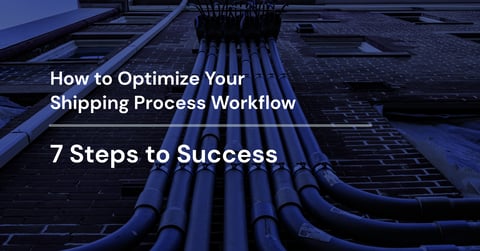How to Optimize Your Shipping Process Workflow

For enterprise ecommerce businesses, a well-optimized shipping process workflow — starting with an order and ending with a delivery at the parcel’s final destination — protects margins, enhances customer satisfaction, and boosts bottom-line profitability.
Let's review the benefits of an optimized shipping workflow and break down seven steps to help you improve your current approach and establish strategies to facilitate continuous improvement.
What is a shipping workflow?
A shipping process workflow is a sequence of coordinated activities and procedures determining how products move from a seller’s location to a customer’s final destination. This structured approach to sending shipments is a blueprint to help organizations maintain consistency and reliability in their operations. The final goal is to align people, technology, and resources to ensure packages are delivered on time and meet buyer’s expectations.
What are the benefits of an optimized shipment process?
For enterprise shippers, an optimized shipment process provides these benefits:
- Improved delivery speed: Organizing warehouses with strategically placed high-demand items reduces picking times and expedites shipping.
- Increased customer satisfaction: Offering multiple shipping options and accurate delivery times ensures you meet customers’ order expectations.
- Scalability and flexibility: Technology integration enables businesses to handle rising order volumes effectively.
How to refine your shipping process
Here are seven steps your ecommerce business can follow to refine your existing fulfillment practices — ultimately increasing your margins.
1. Map out your current process
The first step in optimizing your shipping process is developing a solid understanding of your current performance. To fully grasp the big picture view of your ecommerce supply chain, you’ll need to perform:
- Process analysis: Identify bottlenecks and inefficiencies in your workflow to expose operational roadblocks that impact delivery speed.
- Task tracking: Review time investment for each step of your shipping operation and analyze the costs involved.
- Resource audit: List all tools and resources currently used to identify potential system consolidation opportunities, necessary staffing increases, or required technology updates.
2. Improve your inventory management
From improving customer satisfaction and maximizing sales opportunities to streamlining warehouse packing and preventing human errors, inventory management — or placing your products relative to your customers — is a big piece of the puzzle. As you work to strengthen how you manage your stock across all your channels, from warehouses to stores, you should target:
- Real-time tracking: Implement automated inventory monitoring solutions to prevent stockout and overstock situations.
- Demand forecasting: Use predictive analytics to anticipate inventory needs across all your channels and optimize stock levels.
- Warehouse organization: Structure storage layout based on pick and pack frequency to reduce fulfillment time.
Once you have automated systems to manage your stock across all your fulfillment centers effectively, the goal should be refining your inventory placement. For example, if you sell down-filled jackets and mittens, storing products in your California warehouse instead of your North Dakota warehouse could incur unnecessary logistics costs as you prepare to ship customer orders to colder states.
Using a solution like Shipium, you can leverage your existing forecasting insights to get warehouse allocation recommendations that enable you to provide customers with quicker deliveries and reduce your parcel expenses.
3. Refine your packaging
Smart packaging choices minimize shipping costs while ensuring products arrive safely, while inefficient options can be a costly waste of resources. For example, shipping a single pack of toothbrushes in a box twice as large as the product can result in you paying to ship air.
To enhance your packaging process, target:
- Box optimization: Select right-sized packaging options to minimize dimensional weight costs, lower shipping fees, and speed up order picking.
- Packaging standards: Create consistent packaging rules for product categories to streamline packing decisions.
- Damage prevention: Choose appropriate, cost-effective protective materials, like air pillows, bubble wrap, and custom inserts, to reduce returns and customer dissatisfaction.
Explore how you can optimize cartonization with Shipium's Packaging Planner API.
4. Streamline carrier selection process
When refining your shipping process workflow, it's important to consistently select the right carrier, considering factors like inventory placement, regional considerations, and constant macro-environmental changes across your network.
Poor carrier selection can lead to excessive spending and delivery delays. For example, defaulting to national carriers for local deliveries could mean paying premium rates. Optimize your process and enhance efficiency by improving your:
- Carrier diversification: Balance between national and regional last-mile carriers to ensure that you optimize for cost, delivery speed, and resilience — especially during peak season.
- Rate comparison: Implement and automate fully loaded rate shopping that includes accessorials and surcharges to select the most cost-effective shipping options.
- Performance monitoring: Track carrier delivery metrics to help maintain service quality standards as you strive to hit the best possible rates.
The right mix of carriers can help protect your fulfillment margins. Case in point: after switching to Shipium, Saks OFF 5TH went from one primary carrier to a network of 12, significantly reducing their shipping cost for packages delivered in three days or less.
5. Implement advanced technology in your shipment process
Modern shipping challenges require the right shipping technology, and the best options should unify your systems. Disconnected solutions that create data in silos, for example, using separate platforms for rate shopping and generating labels, or using legacy systems that aren't in constant sync, reduce productivity and can lead to wasted resources.
To modernize your shipping tech stack, prioritize the following:
- API integration: Connect with carriers to automate tasks like shipping label creation and order tracking updates in real-time.
- System connectivity: Link existing supply chain platforms, such as order management systems (OMS) and transit management systems (TMS), to create a seamless data flow, improving how you manage inventory and fulfill orders.
- Parcel intelligence: Implement a closed-loop system to gain end-to-end visibility of the movement of goods through your network.
Unlike legacy shipping solutions that require long lead times to implement changes, modern cloud-based platforms like Shipium allow you to pivot in real-time, from adding a new carrier to adjusting routing rules, without extensive development investment. This faster time-to-value means you can make optimizations and start seeing results immediately.
6. Enhance customer communication
Making ordering and shipping as frictionless as possible reduces the resources necessary to manage customer service inquiries and increases brand loyalty. One of the best ways to boost buyer experience is to add more touchpoints throughout the order delivery process — from “Should I buy this?” to delivery.
You can improve your transparency and communication with customers by providing better:
- Shipping options: Present multiple shipping speeds, letting customers choose their preferred service and price levels.
- Delivery estimates: Display accurate delivery promises at checkout to set clear fulfillment expectations.
- Status updates: Keep customers informed of their shipment progress, reducing support calls and anxiety.
7. Establish a feedback loop for your shipment plan
The most important step in improving your shipping process workflow is to lay out a clear strategy for evaluating how your network is performing at every link of your supply chain. A feedback loop that collects data and remediates gaps or inefficiencies in your operations helps you remain continually optimized thanks to:
- Customer insights: Gather feedback on the shipping experience to identify improvement opportunities, pain points and whether you are meeting customer expectations.
- Performance metrics: Set clear shipping KPIs, such as delivery speed and per-parcel rate, to help accurately measure and track operational success.
- Data analysis: Review shipping patterns and trends to refine your fulfillment strategy accordingly.
Discover how Shipium Simulation insights drive faster feedback loops for your ecommerce business.
What are the main stages of the shipping process?
Here are the three main stages of the shipping process:
- Receiving the order: Purchases are captured through an ecommerce platform or sales channel. The details are logged into the order management system (OMS) for processing.
- Processing the order: The OMS validates the order, ensuring inventory availability and confirming payment. A pick list is generated for warehouse staff to prepare the shipment.
- Fulfilling the order: Items are picked, packed, labeled, and handed to the selected carrier. The customer is provided with tracking information, and the package is dispatched to its destination.
Shipium's enterprise shipping platform optimizes every step of the order-to-delivery process. From routing orders to fulfillment locations closest to your customers and improving delivery speed to predicting scenarios using advanced analytics, our solutions enhance the customer experience and improve decision-making across your operations.
Increase the efficiency of your order-to-delivery process with Shipium
For high-volume shippers, order fulfillment execution is one of the most significant expenses in their budgets. Adopting an end-to-end shipping platform like Shipium can help reduce spending by up to 10% on average, according to a report by Nucleus, with a suite of capabilities that bridge your existing systems, enhance the management orders across your network, and increase conversions with delivery promises.
Book a demo to see how Shipium optimizes the shipping process workflow.
Frequently asked questions
How does an international shipping workflow work?
The shipping workflow to send or receive international goods typically includes these steps:
- Customs clearance at origin: After the order is placed, goods are inspected, and export duties, if applicable, are paid by the exporter. Customs forms are submitted, ensuring compliance with the exporting country’s laws.
- Transportation in ports or airports: Then, items are moved from the warehouse to the port or airport for international transit. During transit, a tracking system monitors the shipment's movement for updates.
- Customs clearance at destination: Customs officials inspect the arriving products in the importing country. The importer calculates and pays import duties and taxes, such as value-added taxes (VAT) or tariffs.
- Final delivery to the customer: Once cleared, goods are handed over to a local carrier for last-mile delivery to the final destination.
What are the key documents used within the shipment process?
Commonly required documents in the shipping process workflow include:
- Bill of Lading (BoL): Serves as a legal contract between shipper and carrier, detailing cargo type, quantity, and destination while acting as a shipment receipt.
- Commercial Invoice (CI): Lists complete purchase details, including prices, buyer/seller information, and payment terms for accounting and customs purposes.
- Packing List (PL): Provides a detailed inventory of package contents, listing quantities, weights, and dimensions for verification and handling purposes.
- Certificate of Origin (CoO): Documents where products were manufactured or produced, essential for international trade and determining applicable tariffs.
- Customs Forms: Required documentation for international shipments that declare contents, value, and purpose for customs clearance and compliance.

Diagonal thinker who enjoys hard problems of any variety. Currently employee #5 and the first business hire at Shipium, a Seattle startup founded by Amazon and Zulily vets to help ecommerce companies modernize their supply chains. Previously was CMO at Datica where I helped healthcare developers use the cloud. Prior to that I came up through product and engineering roles. In total, 18 years of experience leading marketing, product, sales, design, operations, and engineering initiatives within cloud-based technology companies.


